Whether or not the seven mainline denominations of American Protestant Christianity (the United Methodist Church (USA), Christian Church (Disciples of Christ), Presbyterian Church (USA), Episcopal Church, Evangelical Lutheran Church in America, American Baptist Churches (USA), and the United Church of Christ) are truly still “mainline” is up for debate. Some argue they still represent typical American Protestantism; others counter with the prevalence of evangelicalism, broadly speaking (contrasting the usually more liberal view of these mainline churches). What is not up for debate is the rapid shrinking of these once robust seven denominations. Each posts yearly decline, and, over the decades, the bloodletting has become undeniable.
*No reported numbers for 1990, 2010: these have been estimated from 1989 and 2009 numbers. 1960 numbers are combined from Methodist Church and the EUB.
**Before 1982, combined numbers are from UPC(USA) and PCUS.
†Before 1988, combined numbers are from eight branches, available at www.thearda.com.
††Before 1960, combined numbers are from the ERC and the CCC.
United Methodist Church (USA)
UMC is the largest of the seven. The latest numbers on the UMC are from 2017, when membership decreased by 1.89% (a loss from 7,064,602 to 6,932,339). Perhaps more telling is that, in 2017, average church attendance among UMC members dropped more drastically, by almost four percent (3.8%), or over a hundred thousand members. The UMC in America has consistently lost members since the 1960s, when the Methodist Church and the Evangelical United Brethren combined in 1968. In 1969, after the merge, the UMC reported 11,026,976 members.
A brief side note: the global UMC membership increased from 2013 to 2017, from 12.4 million members to 12,557,214. While the U.S. church is decreasing, the international church is growing, especially in sub-Saharan Africa.
Christian Church (Disciples of Christ)
The Disciples of Christ, in the last couple of years, has declined at two or three times the rate of other mainline denominations. Disciples’ last membership report announced a rate of decline at an incredible 7% per year: from 382,248 members to 355,491. Attendance for 2018 was down 11% (from 139,936 to 124,437), in an already-small denomination. The largest loss the church posted was in the baptisms category: 13% fewer baptisms were celebrated in 2017. The Christian Church saw its membership peak 1957-1958, with nearly two million members (1,943,599).
Presbyterian Church (USA)
Still the largest denomination among its fellow Presbyterian churches, the PCUSA also holds the distinction for losing the most Presbyterian members per year. At this rate, more historically orthodox denominations, like the Presbyterian Church in America (PCA), will overtake the PC(USA) as the largest Presbyterian denomination within a couple of decades. In 1982, the final year before the merging of the Presbyterian Church in the United States and the United Presbyterian Church in the United States of America, both denominations had a peak total membership of 3,157,372 (814,831 and 2,342,441, respectively). Last year, membership decreased from 1,415,053 to 1,352,678, or a 4.4% net loss. At its peak, the PCUSA was comprised of 3,788,009 members. Meanwhile, the PCA has posted regular growth for at least the previous five years in every single category (except per capita giving). The PCA baptized 400 people in the year 2018. The PCUSA, three and a half times larger than the PCA, baptized just over twice as many in 2018. Another conservative Presbyterian church lost members, though. The Evangelical Presbyterian Church lost 3,945 members from 2016-2017 (a loss of 2.5%).
A number of Presbyterian groups and denominations have broken off or cut ties with the PC(USA) since they liberalized sexual teaching. For instance, the Presbyterian Church of India, with its membership of 1.4 million, cut off its partnership with the PC(USA). Presbyterian churches in Africa also disagreed with the 2011 removal of the sexual fidelity and chastity clause from clergy ordination vows.
Episcopal Church
The Episcopal Church neither shies away from nor tries to hide its decline. While it will be a few years before the Episcopal Church reaches a critically low point, it is definitely on that path. Last year, membership records showed a 2.1% loss (from 1,712,563 to 1,676,349). The published records themselves note that this works out to a 10% loss every five years. In the same period, average attendance went down by an added 4%, for a total of 14% (a 4.2% decline in 2018 alone). In 2003, the Episcopal Church approved an openly homosexual bishop. It has continued to lose members since that same time at an accelerated rate, thanks partly to departures by congregations and some dioceses to join the Anglican Churchbin North America.
*No data available for 2005; estimated from 2004 and 2006 data.
Evangelical Lutheran Church in America
The ELCA is the second-largest denomination in mainline Protestantism. The modern church came into existence in 1987, when three denominations combined: Association of Evangelical Lutheran Churches, Lutheran Church in America, and American Lutheran Church. As they finished merging, they had a combined membership of 5,318,844 (respectively, 103,263; 2,896,138; 2,319,443). According to the report from 2018, 2.8% (95,558) of its members left the roll, leaving 3,458,839 members behind, but attendance declined by just under 4% (36,583). Among baptized members, attendance dropped a full percent. Baptism may have a stronger hold on members than simple membership, but that bond is not strong enough to staunch the wound.
*No data available for 1985; estimated from 1986.
In 2010, a significant schism occurred within the ELCA, due to the change in belief away from biblical sexual ethics. The North American Lutheran Church formed out of the Lutheran CORE group, announcing that it would be the “theological center of Lutheranism in North America.” Its beliefs fall between the Missouri Synod Lutherans and the ELCA. It has a membership of 142,000 with 424 congregations, and describes itself as a “fast-growing” denomination. The ELCA itself has made clear it is on the path to collapse: by 2041, denominational officials project a Sunday morning attendance of only 16,000 worshippers. Even more noteworthy: they entertain the idea that the reason may be due to a lack of “what’s distinctive about being Christian.”
American Baptist Churches (USA)
While the ABC denomination is technically against homosexual practice (in contrast to many of its sister denominations within mainline Protestantism), “it is important to recall the independent and autonomous structure of the Baptist tradition.” American Baptist churches hold a great degree of autonomy in many aspects, including the area of sexual ethics. A number of churches ignore the denomination’s official disapproval of homosexuality. Much like the rest of liberal mainline Protestantism, the American Baptist Church has been bleeding members, though not as quickly as other denominations. In 2017, the last reported year, the ABC lost 1.2% of its members (just 13,845, of 1,159,492).
United Church of Christ
While it is one of the smaller mainline churches, with 824,866 members in 2018 (larger only than the Disciples of Christ with approximately 380,000 members), the UCC reports one of the higher membership loss rates. It lost 3.4% of its membership last year. On a local level, this means each congregation lost three members (from 174 to 171), and attendance went down by two, from 69 to 67 per congregation. Since it is a relatively small denomination, compared to its sisters, the individual losses are more significant.
The Institute on Religion and Democracy tracks these numbers, not for a “we-told-you-so” purpose, or to pat conservative churches on the back, but in order to alert all churches about the dangers of liberal theology. All Seven Sisters of Protestantism continue to post declining membership. Each one insists that liberal theology is not the problem, but the solution. After decades of decline, it may be time to re-visit that hypothesis. Maybe 2,000 years of tradition is not something at which to scoff.
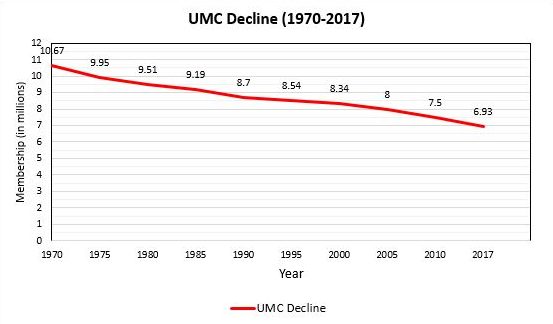
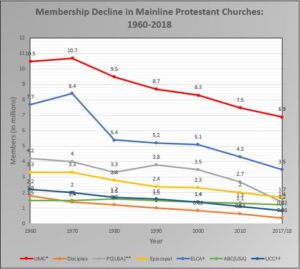
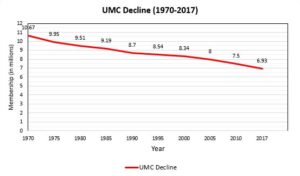


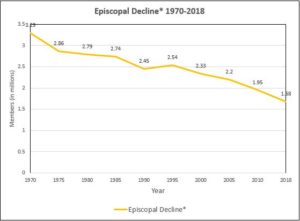
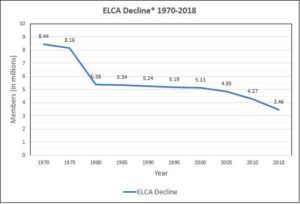

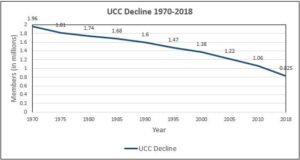




Comment by Rev. Dr. Lee D Cary (ret. UMC clergy) on September 26, 2019 at 12:39 pm
“All Seven Sisters of Protestantism continue to post declining membership. Each one insists that liberal theology is not the problem, but the solution. After nearly twenty years, it may be time to re-visit that hypothesis.” Chances of them “revisiting” that hypothesis are unlikely.
Can’t comment on 6 of the Sisters, but up until the human-sexuality saga in the United Methodist Church (UMC) the hierarchy has been in denial re. the decline in membership, becoming progressively more liberal beginning in the 1960’s.
As the trend line continues at its current pace, the denomination (if it continues to exist as “United”) will reach the U.S. member mark of 5.5 million mark NLT 2014 – with approx. 500,000 U.S. members lost every decade. (The trend line steepened from 2004-2017.) But this is in the US. The growth edge of the UMC is off-shore – largely in Africa – and therein is its hope for future growth.
If/when the widely expected fracturing of the UMC occurs in 2020, the sum-total of its resulting parts will likely represent an immediate bump down. Back when the Evangelical United Brethren Church and The Methodist Church united in 1968 to form the UMC (with 11 million members total), the new organization was somewhat less than the sum total of the two uniting parties.
When members lose their long-held church identity, they sometimes go shopping for a new one, rather than accept the one that swallowed their old church home. I watched it happen. And today, in the US, the options for a new church home that is a non-denominational independent church are rapidly expanding.
Comment by JR on September 26, 2019 at 3:26 pm
What are the comparable numbers among other denominations?
Do the American Catholics have similar declines? If so, one could infer that it’s not the liberal lean of the theology but instead the affect of American culture overall.
Just a line of thought to consider.
Comment by Steve on September 26, 2019 at 3:42 pm
The Catholic Church in the USA is in decline. There are problems with Church attendance, lack of doctrinal awareness among the laity and in cash receipts. The Catholic Church in the USA loses about 7 people for every 1 it takes in. Liberalism has moved into the Catholic Church and correlates well it’s decline. I am Catholic and this causes me no joy.
Comment by John Schuh on September 29, 2019 at 2:48 am
The moral rot began when many of the Catholic clergy bought into the sexual revolution. But liberalism does underlie most of it. The radical individualism that infects our society but also the comfortable like persuades people they are in control.
Comment by Steve Harvester on February 8, 2020 at 7:41 am
Right wing evangelical churches aren’t winning secular people over, either. In the South, they retain some of the cultural support that all churches had 1945-65. Sunday morning is now a free market. Shopping and sports are beating religion, hands down.
Comment by William on September 26, 2019 at 5:45 pm
So, the great mystery of our age is their stubborn, stiff neck march to extinction.
Comment by David on September 26, 2019 at 7:14 pm
People “inherit” their denomination to a degree from their parents and you cannot have birthrates below replacement levels since the 1960s and not expect memberships to decline. The churches in question might be described as white, a group whose most common age is currently 58. The annual number of white deaths as of 2015 is greater than the number of white births. Immigrants to the US tend not be members of the “seven sisters.” These trends were churning long before gay marriage was a matter of discussion.
Comment by Steve on September 26, 2019 at 9:29 pm
Nope. So much wrong there. But here’s one example: gay marriage was an issue in the Episcopal Church as early as 1975 per this timeline:
http://outhistory.org/exhibits/show/religion_homosex/episcopal
Not saying that the declines in white birthrates doesn’t affect membership, but the Episcopalian rate of decline has far exceeded that of the birthrate. As I have pointed out before, the Episcopal Church is expected to be extinct in the next few decades, the same cannot be said for white people generally. White people will be one of many large minorities, but the Episcopal Church will be gone, except as a holding company for its extensive assets. There will be plenty (although short of a majority) of white people, but few will want to attend the Episcopal Church. I conclude its because they made affirming homosexuality the defining issue; there’s no place for the person in the pews to hide; they are given the choice of being a homophobe or disregarding the literal language of the bible. A no win situation people understandably avoid.
Comment by JR on September 27, 2019 at 9:44 am
But if Catholicism is seeing similar declining trends, it’s not about gay marriage.
It’s more likely to be ‘religion’ in general.
Comment by Lee D. Cary on September 27, 2019 at 10:05 am
Perhaps the RCC’s unwilling to directly confront the pedo-priest issue is also a factor.
Comment by Steve on September 27, 2019 at 10:59 am
Of course religion in general is on a downward trend, and birthrates are down, so these things do contribute to the decline as well, but I was around to see Gene Robinson’s ordination devastate our previously large vibrant parish, so in my personal experience I’d say the affirming homosexuality also contributed substantially to the Episcopal Church’s long term decline. It’s often said that the Episcopal Church is in a race to lose the most people, and I don’t think its a coincidence that its one of the most liberal. Saying that all denominations are losing people is not a good excuse for being one of the fastest shrinking denominations. I’ve said it before, but one of my favorite news article titles is “How to Shrink Your Church in One Easy Step”. The one easy step is so obvious we know what it is even before reading the article, don’t we?
Comment by John Smith on September 30, 2019 at 6:06 am
This is called grasping at straws. If it is religion in general then all denominations would be in decline at similar rates. To claim decline in the RC sect validates mainline protestant denominations to overlook the significant differences between the two.
Comment by MJ on September 26, 2019 at 7:51 pm
Since the ELCA was founded in 1988, it’s membership never rose above approximately 5.3 million members. And, yes, there has been a steep decline since then. I suspect, though, that, along with the ELCA’s predecessor bodies you are including the membership of the Lutheran Church – Missouri Synod in the numbers from the 1970’s. Since only a small portion of the LCMS eventually joined the ELCA, I wouldn’t have included the whole LCMS in the stats from the 70’s.
Comment by Paul W. on September 27, 2019 at 2:19 am
These declines are far worse than they appear when you adjust them to show them as percentages of the total US population over the 50 year time frame. The US population has increased over 50% from 205 million in 1970 to 329 million in 2019. When viewed in this regard, you gain a far greater appreciation for how far the mainline denominations have really fallen in regards to cultural significance.
Comment by Lee D. Cary on September 27, 2019 at 10:12 am
But in the meantime, the collective body of independent, non-denominational congregations is spreading, as the era of hierarchical, clergy-dominated, bureaucratic, traditional liturgical “denominations” fades.
Have you noticed that some Southern Baptist churches have rebranded with non-denomination monikers (like, “Horizon Church”) while inserting a statement in small type below on their street signage indicates affiliation with the Southern Baptist denomination? They saw the shift coming and were early adaptors.
Comment by William on September 27, 2019 at 2:25 pm
UM churches are doing the same in some places. There are two large congregations in my community of which I’m aware. From the street/road, there is no way of knowing that these churches are but nondenominational community churches — no cross and flame or even small print United Methodist.
Comment by David Gingrich on September 28, 2019 at 7:06 am
William, I don’t think that will work for the UMC. The problem is the UMC hierarchy. People attending a non-branded church will discover that in very short order.
Comment by Mike Butler on September 27, 2019 at 11:01 am
Sucked dry by the tick of the ICCR and social responsibility movement. The religious lefts new great commission
Comment by senecagriggs on September 27, 2019 at 12:17 pm
RE: The Roman Catholic Church. If the Pope sees “Climate Change” as the penultimate world problem then the Roman Catholic Church is effectively dead.
Comment by Leigh on September 27, 2019 at 10:52 pm
The Catholic Church has survived far worse Popes.
Comment by Ted R. Weiland on September 27, 2019 at 6:04 pm
America doesn’t need more churches. The more churches, the more infanticide clinics, sodomite parades, drag queen library shows, abominable legislation, etc.
God did not call Christians to church but to ecclesia, that is, to form Christian communities in the fullest sense of the word. In turn, this means dominionizing society, including government, per Romans 12:21, 13:1-7, 1 Corinthians 6:1-6, 2 Corinthians 10:4-6, etc.
Time for Christians to once again take seriously their dominion mandate and actually be a light to the world and the salt of the earth rather than mere four-walled, stain-glassed Christians pewtrifying in their churches.
For more, Google free online book “The Romans 13 Template for Biblical Dominion…”
Comment by Loren J Golden on September 27, 2019 at 7:10 pm
“The Institute on Religion and Democracy tracks these numbers … in order to alert all churches about the dangers of liberal theology.”
Citing numbers is not enough to fulfill this purpose. Liberal theology has dominated each of the “seven sisters” (or their organizational predecessors) for the past century or more, and until the 1960s they all enjoyed numerical growth despite the same anti-Biblical, anti-Christian theology that dominates them today. Cause-and-effect traceability needs to be shown, to demonstrate how liberal theology in each of the “seven sisters” has contributed to their catastrophic numerical losses experienced over the past half century.
Comment by David Gingrich on September 28, 2019 at 7:10 am
Loren, I hope our heads are not in the sand. IRD has published a myriad of information on your question, showing for example how orthodox UMC churches in the South are not seeing the loss that liberal churches in the Northeast and West are seeing.
Comment by Loren J Golden on September 28, 2019 at 10:14 am
This is circumstantial evidence at best. My point is that it needs to be demonstrated precisely HOW liberal theology contributes to church membership loss, whereas orthodox theology contributes to church membership gain. Otherwise, the theological liberal, with his or her proverbial head in the sand, might say, “The South has a culture that promotes churchgoing, whereas the Northeast and the West do not, and that explains why churches in the South are growing, whereas churches in the Northeast and West are floundering.” Moreover, there are examples of churches espousing liberal theology that grow numerically even today and churches believing the Bible and preaching the Gospel that lose members, and this fact will not be lost on theological liberals. One might point to an overall trend, but if we do not explicitly make the connection, what more do we have to say that the liberal cannot figure out for him or herself?
Comment by Steve on September 29, 2019 at 7:03 am
Upton Sinclair — ‘It is difficult to get a man to understand something, when his salary depends on his not understanding it.’ Its common in all organizations that the people at the top will claim they have a great business model and the only thing that stops the rosy scenairos is going out of business. Example: Theranos. By the way, circumstantial evidence is perfectly valid evidence. It’s clear that there’s almost a direct correlation between the liberality of a denomination and how quickly it’s declining. Whether people choose to heed the signs or not is totally up to them. People smoke even though a causality re cancer is pretty clear (though the tobacco companies challenged the causality pretty effectively as long as they chose to). On the other hand, clearly, going conservative wouldn’t be a complete cure. Numbers are down everywhere, the real issue is how soon one wanted to go out of business. We all die someday, but most of us prefer that it not be soon.
Comment by Loren J Golden on September 29, 2019 at 3:01 pm
You really did not read what I said, did you?
I did not say that circumstantial evidence is not valid evidence, but I did imply that it is not sufficient, in and of itself, to prove its point. Neither did I even remotely suggest that “going conservative (would) be a complete cure.”
Young Mr. Aden stated his thesis only at the end of his article, and the only evidence he produced in support of it was that the seven Protestant denominations most heavily influenced by theological liberalism have experienced catastrophic levels of membership loss over the past half century. You will kindly note that I am challenging neither his thesis nor the circumstantial evidence that he has put forward to support it. I am, however, challenging the lack of analysis that demonstrates precisely how theological liberalism in these denominations has contributed to this membership loss, for without this analysis, he has failed to prove his thesis.
Comment by Steve on September 29, 2019 at 10:06 pm
Dear Mr Golden:
Did you read the article? It ends using the qualifiers “may be” and “maybe”. He does not claim to have proven anything beyond peradventure. You say he has offered a thesis, it looks more like a hypothesis to me. As for liberalism, there’s a whole lot that might go under the rubric. There might be some aspects of liberalism that I find offensive that you find intolerable. To a large extent its a matter of taste and belief, and each person is going to have a different idea of what is the correct balance between tolerance and adherence to doctrine. Given this, it is fundamentally impossible to say there is any one aspect of liberalism, or collection of aspects, or that liberalism as a whole that has particularly caused people to leave. However, just like a ratings services knows if classical, country or rock music stations get better ratings, so it goes with liberal versus conservative denominations. Yes, categories oversimplify. Its always nice if we can be more exact. But its also important to know when one a reaching the end of the available information or the point of diminishing returns. You can always try and do the work you suggest if you believe it to be doable and/or important.
Comment by Loren J Golden on September 29, 2019 at 10:51 pm
“Did you read the article? … You say he has offered a thesis, it looks more like a hypothesis to me.”
Yes sir, I did read the article from beginning to end. Mr. Aden’s thesis is thus: “The Institute on Religion and Democracy tracks these numbers, … in order to alert all churches about the dangers of liberal theology.” This is akin to the surgeon general’s warning regarding the dangers to one’s health of smoking: the analysis to prove the thesis has been done, but it is not presented in the warning. Neither is the analysis in Mr. Aden’s article present to prove his thesis.
“You can always try and do the work you suggest if you believe it to be doable and/or important.”
Just as you had not read what I said in my response to Mr. Gingrich before you replied to it, neither, it would seem, have you followed the link to my blog, available in my name in each of my responses on this website. In particular, I would point you to two posts, entitled, “Now Celebrating Fifty-One Years of Uninterrupted Decline by Mishandling the Word of God…” and “When Progress Founders: An Evaluation of the Presbyterian Church (USA)’s Efforts to Reform Itself”.
Comment by Paul W. on September 30, 2019 at 2:20 pm
Loren, I share your frustration. The folks taking you to task appear not to realize that 1) you are in violent agreement with them on the deadly fruit of liberal theology, and 2) your only criticism is that, while the article clearly documents the 50 year decline of the Mainline denominations, the article is generally silent on the reasons for the decline, neither demonstrating nor showing that liberal theology is the cause of the decline; hence, the conclusion/summary paragraph is out of step logically with what was actually presented in the article.
Comment by Randy on September 28, 2019 at 10:08 am
I’ve witnessed a new awakening among people outside the church. People offer to pray for others and send positive vibrations when others tell of their difficulties. These prayers are unchurched as far as I know. When I inquire about their spiritual beliefs, they relate a loving account of God’s blessing in their lives. They describe this knowledge as coming from within. They seem to have something that most church goers don’t have…A love for all humanity. They don’t fire bible scripture at me either mainly because they aren’t reading the bible. They don’t need a church or scripture in order to show love. It’s an awakening happening outside the church.
Comment by Todd Collier on September 28, 2019 at 4:24 pm
Just briefly looking at data that suggests that churches with more conservative stances are at least holding their own while those that represent/enforce orthodox morality are growing. First we must acknowledge that the actual percentage of Americans attending church hasn’t changed all that much over the past few decades. So, while the “nones” have grown, it has not been at the expense of attenders, but of those who were culturally attached to a particular group. For most of the past decade, the fastest growers in attendance are teaching orthodox morality while being extremely heterodox in their theology – the Witnesses and the Mormons. This would suggest that the liberal lifestyle issues are larger concerns to “seekers” than actual Christology. Those orthodox groups that are growing are conservative in theology and doctrine and tend to be “non-denominational.” So, I think it is very difficult to blame the loss among these denominations as “normal attrition” or as not related to their heterodox views of Scripture and lifestyle.
Comment by Skipper on September 28, 2019 at 6:43 pm
Isn’t it shocking how many of these “sisters” have been tragically corrupted by the power of darkness into accepting sexual perversion? Yet, individuals can turn back to God, if still breathing. Jesus said few would find the Narrow Way.
Comment by Skipper on September 29, 2019 at 9:38 am
J. Vernon McGee said “If they don’t teach what the church teaches, they’re not a church.” So that just leaves the United Methodist Church and the American Baptist Church standing. The others have accepted the evil of sexual perversion and reduced themselves to social groups serving the culture or world. Jesus said many would take the wide and easy road that leads to destruction. Today we see that happening as former churches embrace evil.
Comment by Matt on September 29, 2019 at 7:54 pm
“Maybe 2,000 years of tradition is not something at which to scoff.”
Here we see one of the most intellectually dishonest and downright deceptive lies the evangelical movement will tell you. “There is unbroken theological line between Jesus and us; we just live by the Bible”.
[Expletive removed].
Try this: go to the men in your evangelical church’s leadership (they’ll all be men) and tell them you’d like to lead a study in Sunday school or small group about the history of protestantism and Martin Luther; Wittenberg, the Anabaptists and their beliefs, etc. Better yet, ask about the history of the Bible. Not history *in* the Bible, history *of* the Bible. Those who wrote it (the few authors we’re certain of), when it was written, how is was compiled and edited and abridged by multiple cultures in multiple languages over the centuries.
You’ll be shut down in seconds, trust me. Try it.
Therein lies the deception. The more information you have about the Bible, about the varied, complicated and muddled history of the faith, the less patience you’ll have with rigid, dogmatic and authoritarian spiritual abuse. They know, they study it in seminary, but the information is seldom taught to the congregation.
Comment by GW on October 3, 2019 at 11:16 am
There’s no question what sexual moral ethic the Bible teaches, and only perverts are attempting to promote homosexuality and the pedophilia that accompanies it. The righteous and faithful aren’t promoting this garbage. Jesus said that even mere lustful thought toward a woman would send a man to hell; how will he judge the practice and promotion of far worse sins (sodomy)? Take careful note this question isn’t just academic. Woe to those who call evil good.
The Bible was written by a variety of men at a variety of time, and the very words they wrote are inspired by the Holy Spirit. In His sovereignty God kept and preserved the scriptures over time, so that what we read today is still profitable for doctrine, reproof, correction, and instruction in righteousness.
We can also have confidence in the Bible that even the reformers couldn’t have, due to the systematic processes that have been developed in the fields of textual criticism and archaeology. The Bible has more manuscripts (by far) than any other ancient document, and material from parts of the New Testament (certain creeds quoted by Paul) can be dated to within five years of the crucifixion. We’ve been able to validate many historical places and objects thanks to the biblical text. Because of these reasons we know with much certainty what the original text stated, allowing your modern Bibles to be accurately translated (whether all of them are or not is another topic).
Despite undue skepticism of the Hebrew scriptures, we have multiple reasons to trust it. The messianic prophecies in the OT have been fulfilled in Christ and compel belief. The rabbis have had to ban the reading of Daniel 9 because of how clearly the passage spells out the return and “cutting off” (execution) of the Messiah was to precede the destruction of the city and temple. AD 70 came and went, and the Jews are without defense in maintaining their unbelief. Isaiah 53 spells out the crucifixion and resurrection 700 years before Christ with such clarity that before we found the Dead Sea scrolls (dating this passage to the BC era) many liberal skeptics assured us it was a Christian connivance snuck back into the Old Testament.
In summary, the opposite of what you conclude is true. The more you study the Bible, the more you see how the scriptures support and build of each other. Compare Exodus with Matthew, for instance. Moses led Israel out of Egypt, Jesus came out of Egypt following his family sojourn to flee Herod. Israel passed through the waters of the Sea of Reeds, Jesus did the same in his baptism. Following going through water, Israel spent 40 years of testing in the wilderness where they were given the Torah. Jesus followed his baptism with 40 days of testing, responding to Satan’s lies by quoting the Torah (Deut. 6&8). The story is clear to someone versed in midrashic technique; Jesus succeeded in righteousness where Israel had failed.
The more you understand about the history of the Bible, the more you see God’s hand of providence behind it. Your lack of faith is damning and you should repent of it.
Comment by Ralph Weitz on November 26, 2019 at 2:59 am
I like your premise of teaching protestant church history which I like to say is teaching church doctrinal history, and teaching the origins of the Bible which I include in my Apologetics classes and NT survey. I agree the church had done a poor job of teaching the history of doctrinal development. And certainly an even poorer job of confronting the higher critical view of the Bible for which there is ample scholarly rebuttal. For twenty years I have taught Apologetics and NT Survey as optional SS classes on a two year cycle. Never has there been a want for students, even at times we have had to discontinue class registration. .We do a disservice to our congregations and especially our college students when we ignore these two topics. i think the church needs to be introduced to world class scholars like Timothy Luke Johnson, F.F. Bruce, N.T. Wright and other able scholars. I never had a problem of getting approval for such classes in my evangelical church.
Comment by David on September 30, 2019 at 12:33 pm
It is interesting to compare the theme of this article with an article on the decline of fraternal organizations where religious doctrines are not a matter of dispute:
“However, this problem is not unique to masonry. All membership based organizations, from churches, sports leagues, scouting, professional associations, labor unions, chambers of commerce and other civic groups are all experiencing accelerating membership declines with numbers of new members not keeping pace with aging memberships and a general lack of relevancy in today’s ever increasing time starved lifestyles…”
Comment by Donald on October 19, 2019 at 10:23 am
Just came from a PC(USA) presbytery meeting being held in the sanctuary of a congregation whose majority of membership left the presbytery after paying a confiscatory ‘exit fee.’ That congregation grew to nearly 1K, had three services and active ministries and mission on a 25 acre site.
The remaining congregation is in the process of selling off a majority of that acreage. Speaking with an elder, he acknowledged they ‘can’t make the payments’ and ‘hope the cash will help us remain solvent for years to come.’
Our presbytery lost eleven of its largest congregations in this battle. So while the presbytery is no longer ‘cash poor,’ it also is poor in many other ways. The congregations which left have continued to grow. The ‘faithful remnant congregations,’ not so much.
Comment by Elizabeth on November 14, 2019 at 5:19 pm
When was Jesus’ message ever “do what is super popular because it’s obviously good and God ordains that it should be so”? Maybe mainline churches are trying hard to bring the church forward and meeting a natural resistance to change. Maybe what is right isn’t always what is popular.
At the very worst, we are wrong, but we are trying hard to do right. We honestly see the advances the world has made in understanding gender and sexuality as opportunities for the church to grow in its understanding of what is right. My aunt was married to a closeted gay man who faked his way into the marriage. She wouldn’t divorce him because she thought God didn’t want her to. Her kids are a mess, not coincidentally — one committed suicide — and she is living a horrible life on the two pennies he left her to rub together when he dumped her. Was that really more of a marriage in God’s eyes than the two lesbian women I know who love each other and support each other and are raising their children to serve God and others? They’ve been married 15 years, and their union is too good and kind and unselfish and gentle not to be real.
Whether it is or not, I am certain that Jesus would not like Christians sneering at other branches of the church for trying to follow him as they think He would want and experiencing membership declines. He was always correcting his apostles for that kind of thing — sneering, self-righteousness, jockeying for who was closest to him.
If I saw Christ’s church as devoted to poorly disguised smugness at the expense of others, gay conversion therapy that damages kids, and sham marriages like my aunt’s, I’d leave it too. Give me a small, unpopular church, where I’ll worship with Kate and Debbie and their kids. If I’m wrong, I think Jesus will forgive it because I do what I do in love.
Comment by Liz on January 22, 2020 at 3:03 am
And I heard another voice from heaven, saying, Come out of her, my people, that ye be not partakers of her sins, and that ye receive not of her plagues.- Revelation 18:4
When these lines signed for their 501c3 bribe in the 50s, they set their fate. I’ve said this to others and I will say it here. God is calling His people out of these apostate churches even if that means that they will only be able to worship at home.
Comment by Madeleine on April 19, 2020 at 2:50 pm
I noticed that this analysis omits Unitarian Universalism, the most liberal of American denominations, and the one that is reporting the most rapid growth. I personally do not care for UUism, but suggest that its success does contradict the position that liberalism is linked to decline.
Comment by Steve on May 17, 2020 at 11:12 am
Unitarian Universalism is not “reporting rapid growth”.
In fact it is declining, but at a relatively slow rate.
From the Universal Unitarian Association’s own website:
Year Churches Membership
2015 1,043 156,620
2016 1,038 154,965
2017 1036 153,574
2018 1035 154,790
2019 1029 154,704
2020 1027 152,921
The number of members is so low (in ACNA territory) that its best understood as an insignificant outlier. If you want to see a denomination with similar membership but with actual growth, consider the ACNA (which is traditionalist). I wouldn’t make any big conclusions based on the ACNA numbers either. I think the UU’s relatively benign numbers has something to do with them being consistent in their beliefs over the years. Radical doctrinal changes will tend to make congregants flee faster.
Comment by Robert on July 2, 2020 at 10:01 pm
I and 68 years old and “raised” a Presbyterian – now the PC (USA). I haven’t attended services in – many – years but now would like to reconnect, but not with a dying denomination. Of course, by not attending I’m part of a self fulfilling prophesy, I guess. I do believe in equality for LGBTQ folks both as partners and in denominational ministry. If God created everyone equal then why not? BUT, the PC (USA) probably has more years left than I but I’d still like to be a part of a thriving denomination which supports my views. And that would be the “Seven Sisters”? My wife is Catholic but too many problems there and too “regalia” and ceremony for my tastes. Not exactly non-traditional folk friendly either. LDS – Mormon? Been there, done that decades ago. Historical past falling apart year by year and definitely not LGTBQ/race friendly. I’d like a denomination which is friendly to the above folks but still based on the bible and not obsessed with climate, gun control, and a myriad of other social issues. So where do i go: try to find a non-denominational church? I’m lost!
Comment by Sasha Kwapinski on September 13, 2020 at 9:54 pm
While attending California Lutheran College (now CLU) in the late 1960’s, I saw the beginnings of the liberal,”politically correct” drift in the ELCA (ALC and LCA at that time), as well as the other mainline denominations. I am still around to see the end results, as they decline into irrelevancy. “Liberal theology” is little more than liberal politics, combined with moral relativism — not worth the effort to get out of bed and go to church on Sunday.
Comment by Dave W on June 3, 2022 at 10:04 am
I have been visiting my local mainline churches, and they are overwhelmingly gray (senior). Some churches are only pulling 35-45 in attendance per Sunday worship service (though a lucky one of those churches has three Sunday services… so they’re doing OK, numberswise). Fact of the matter is that the mainline denominations are mostly about to close shop, except for the few that will merge and toss away once hard fought theological beliefs in the name of sheer survival. For those who don’t have a car, getting to church will be more difficult when it’s a dozen blocks away instead of two. Will that cause folks to visit non-mainline churches? My ‘money’ is on those folks likely fading from the faith altogether.
It’s strange to think that ‘liberal Presbyterianism’ will soon be a thing of the past. It’s almost there already. What would Fred Rogers say…?